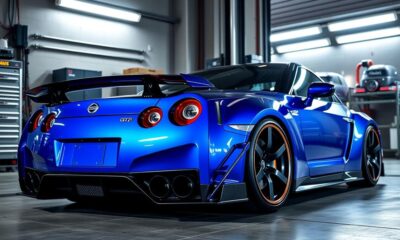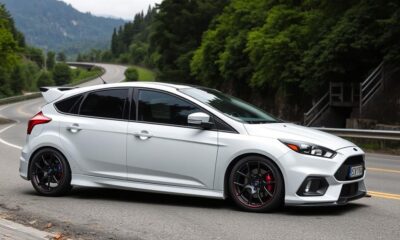Tesla Tuning
Is Tesla Insurance Cheaper? Find Out the Surprising Answer!
Wondering if Tesla Insurance can save you money? Discover the surprising truth that might change your perspective on your premiums!

Tesla insurance isn't generally cheaper compared to the national average. In fact, the average full coverage costs about $329 a month, which is 59% higher than typical rates. However, if you've got a high safety score, Tesla Insurance might offer competitive quotes that could lower your premiums. The costs stem from the vehicle's high value and specialized repair needs. That said, you can still find ways to save, like increasing deductibles or maintaining a clean driving record. Curious how to optimize your savings with Tesla Insurance? There's more to explore on this topic!
Key Takeaways
- Tesla Insurance generally offers competitive quotes, often lower than major providers, especially for drivers with high safety scores.
- Average insurance costs for Teslas are significantly higher than the national average, with full coverage averaging $329/month.
- Model 3 insurance is particularly expensive, costing about $251/month, 70% more than similar vehicles.
- Higher repair costs due to specialized parts and service contribute to elevated insurance premiums for Teslas.
- Personalized premium rates based on driving behavior can lead to savings for safe drivers using Tesla Insurance.
Cost Comparison of Tesla Insurance

When comparing the cost of Tesla Insurance to traditional auto insurance options, you'll likely notice significant differences. On average, full coverage for a Tesla costs about $329 per month, which is a whopping 59% higher than the national average for auto insurance.
If you own a Tesla Model 3, expect to pay around $251 monthly, making it 70% more expensive than similar vehicles in the market. Even the Model X, the cheapest Tesla to insure, costs about $207 per month, still 40% above the national average.
One reason for these higher premiums is the elevated value of Tesla vehicles and their specialized repair needs, with average repair costs often exceeding $5,500.
However, it's worth noting that Tesla Insurance does offer competitive quotes, especially for drivers with high safety scores, compared to major providers like Geico and Allstate.
Factors Behind High Insurance Rates
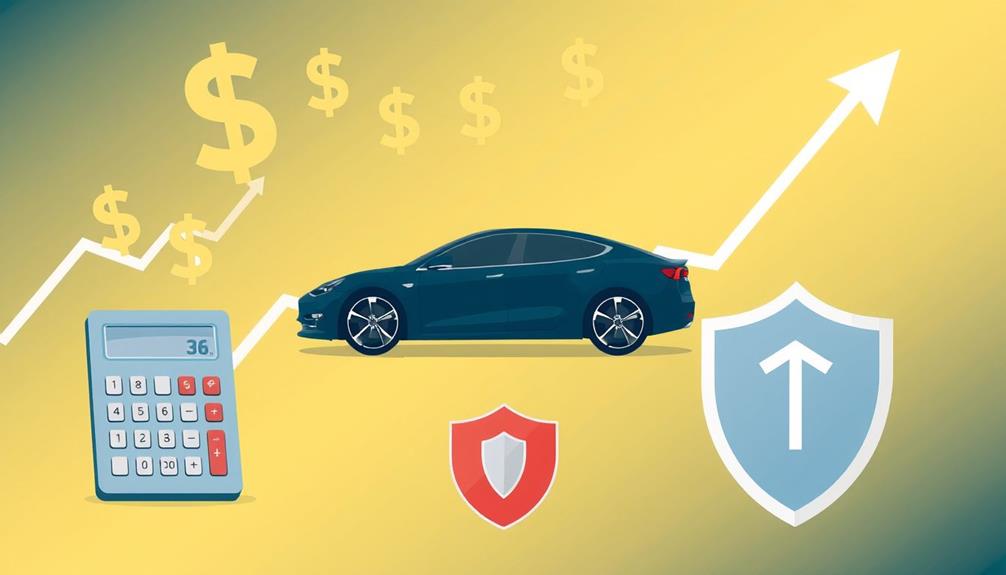
When it comes to insurance rates for your Tesla, several key factors come into play.
The vehicle's high value and expensive repair costs can greatly drive up your premiums.
Plus, your driving behavior is assessed in real time, meaning your habits can also impact what you pay for coverage.
Vehicle Value Impact
Tesla's distinctive blend of advanced technology and luxury features contributes greatly to its vehicles' higher insurance rates. When you consider the factors behind this, it's clear that vehicle value plays a considerable role.
Tesla uses cutting-edge components and design, which boosts the market value of its cars, making them more expensive to insure.
Here are some key factors that impact insurance rates due to vehicle value:
- Higher Market Values: Tesla vehicles generally have elevated market values, leading to increased premiums.
- Repair Costs: With an average repair cost of $5,552, Tesla's expenses are notably higher than those of non-Tesla electric vehicles.
- Specialized Parts: Limited repair options and specialized parts within Tesla's service network raise repair expenses.
- Risk Factors: The potential for severe damage from heavier batteries and rapid acceleration increases risk for insurers.
- Geographic Influence: Local accident statistics and repair market conditions can further affect your insurance costs.
Understanding these factors can help you navigate the complexities of Tesla insurance and prepare for the higher premiums associated with owning one.
Repair Cost Considerations
Repair costs play a crucial role in determining insurance premiums for Tesla owners. The average repair cost for a Tesla is $5,552, markedly higher than for non-Tesla electric vehicles. This stark difference contributes to elevated insurance rates that you might face.
One reason for the high repair costs is the specialized parts and service centers needed for Tesla repairs. These requirements often lead to increased expenses and longer claim processing times, further impacting your insurance rates. Limited parts availability can also cause complications during the claims process, making repairs not only costly but also time-consuming.
Additionally, the heavier batteries and rapid acceleration features of Teslas increase the potential for severe damage in accidents, raising your overall risk profile. Historical data shows that higher vehicle values, like those of Teslas, correlate directly with increased insurance premiums due to the higher risk involved in insuring more expensive vehicles.
Considering these repair cost considerations, it's evident that owning a Tesla can lead to higher insurance rates. As a Tesla owner, it's important to be aware of these factors when evaluating your insurance options.
Driving Behavior Assessment
Insurance rates for Tesla owners can fluctuate greatly based on driving behavior. Tesla Insurance employs real-time driving data to assess how your habits impact your premium. The safety score plays an essential role here, with a score of 90 being the baseline for calculations.
If you maintain a higher safety score—between 97 and 98—you can enjoy markedly lower insurance rates due to the perceived lower risk associated with your driving.
Here are some factors that can influence your insurance rates:
- Mileage Limits: Higher mileage can lead to increased risks and costs.
- Accident History: A clean driving record contributes to a better safety score.
- Geographic Location: Your area may have higher accident rates, affecting premiums.
- Driving Frequency: More time on the road increases exposure to potential claims.
- Type of Coverage: The coverage you choose can dramatically alter your rates.
Understanding these factors can help you manage your safety score and potentially lower your premiums, steering you towards more affordable Tesla insurance rates.
Benefits of Tesla Insurance
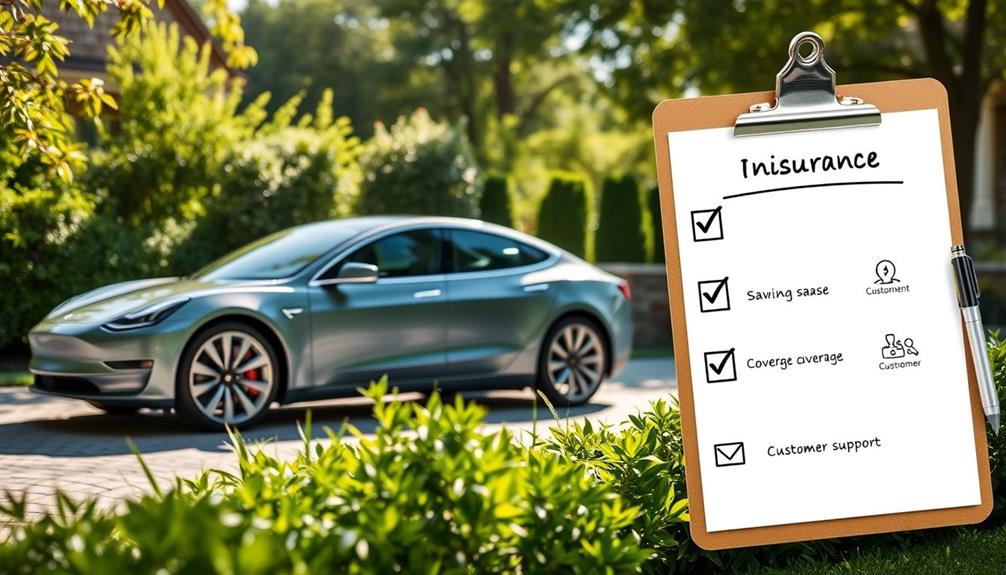
For Tesla owners looking to save money and simplify their car coverage, choosing Tesla Insurance brings a range of benefits. One major advantage is the competitive pricing, often offering lower quotes than major providers like Geico, All State, and Farmers. This affordability can be a game-changer for many Tesla drivers.
Another benefit is the potential for significant savings based on your driving behavior. If you consistently achieve high safety scores between 97-98, you can enjoy reduced insurance rates. Tesla's unique approach to car insurance leverages real-time driving data, tailoring premiums to your individual habits. This means safer drivers can reap rewards.
The setup process for new policies is straightforward, making it easy for you to get started. Plus, managing your insurance digitally through the Tesla app offers unmatched convenience. You can quickly make updates and adjust your coverage, all at your fingertips.
In essence, Tesla Insurance not only provides a more affordable option but also enhances your overall experience as a Tesla owner. With all-encompassing policy management and personalized pricing, it's designed to meet your specific needs.
Unique Pricing Methodology

Tesla Insurance stands out with its unique pricing methodology that taps into real-time driving data.
Your safety score plays an essential role; if you maintain a score above 90, you could access lower premiums.
This approach not only personalizes your rates but also eliminates the hassle of extra tracking devices.
Real-Time Driving Data
When it comes to understanding premium rates, real-time driving data plays a crucial role in how you're assessed. Tesla Insurance stands out by utilizing this data to tailor your premium based on your actual driving habits. This innovative approach means you won't be judged solely on demographic factors or historical data, but rather on how you drive.
Here are some key elements that influence your premium:
- Driving frequency: How often you hit the road matters.
- Mileage: The distance you cover also plays a significant role.
- Vehicle model: Certain models can affect your rates differently.
- Driving habits: Your specific driving style is taken into account.
- Data collection: All this info is pulled directly from your Tesla, eliminating the need for additional devices.
This unique pricing methodology is currently available in 11 states and is backed by the analysis of over 50 million auto insurance rates from various providers.
Safety Score Impact
Many drivers mightn't realize how their safety score can directly influence their insurance premiums. Tesla Insurance employs a unique pricing methodology that taps into real-time driving data, placing a strong emphasis on your safety score. If your score hits 90 or higher, you could see considerably lower quotes. Scores consistently between 97 and 98 can lead to even more substantial savings on your premiums.
The safety score metrics can differ based on your state, meaning your driving behavior can have a direct impact on your insurance costs. This innovative approach rewards safer drivers, unlike traditional insurance models that primarily rely on demographic factors. Fundamentally, the safer you drive, the more you save.
As of early 2024, Tesla Insurance is offered in 11 states, enabling you to take advantage of this real-time, data-driven pricing model. If you've been practicing safe driving habits, it's time to see how your safety score can work in your favor.
Lowering your insurance costs while promoting good driving practices? That's a win-win situation!
Claims Process Insights
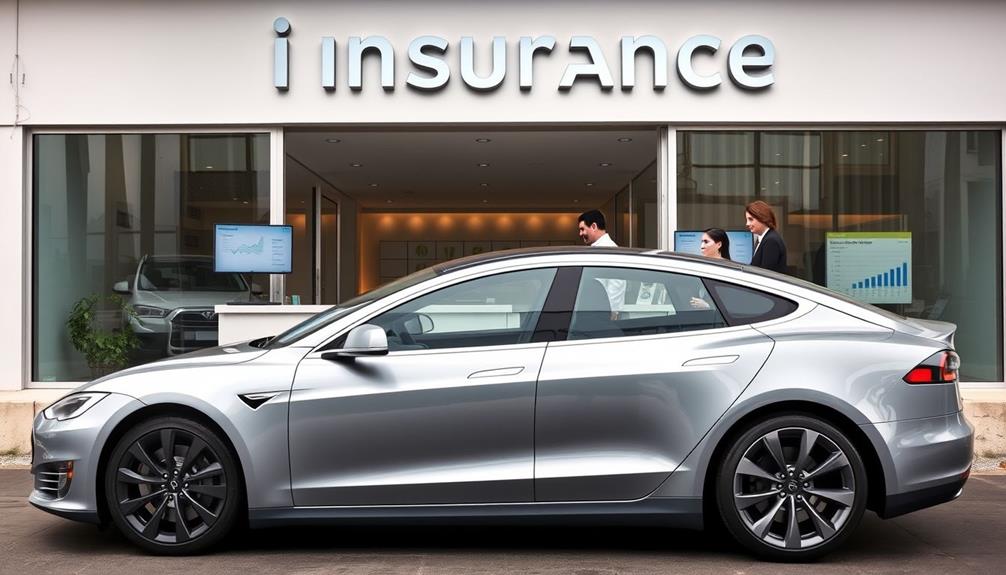
Maneuvering the claims process for Tesla Insurance can feel overwhelming at times. While the app allows you to initiate your claim by submitting accident details and photos, there are several aspects to keep in mind that can complicate your experience.
- Initial communication with claims adjusters often starts via email and may shift to text, which can delay updates.
- Long wait times for general support can exceed an hour, making it frustrating to get timely assistance.
- Many policyholders report a lack of proactive communication from adjusters about claim status, leaving you in the dark about next steps.
- Rental cars are provided for up to three weeks during repairs, but unclear communication can complicate this benefit.
- Overall, customer support challenges can hinder your claims process experience compared to other insurance companies.
Understanding these points can help you navigate the process more effectively.
While Tesla Insurance aims to streamline claims through their app, the reality is that you'll need to advocate for yourself to guarantee you're informed and supported throughout the claims process.
Customer Support Experiences

Maneuvering the claims process often leads you to the next challenge: customer support experiences with Tesla Insurance. Many customers report long wait times, often exceeding an hour, when trying to reach general support for claims.
This delay can be frustrating, especially when you need timely assistance regarding your auto insurance.
Communication with adjusters typically starts via email and shifts to text, but many users struggle to get clear answers about their claims.
When you proactively engage with claims adjusters, you might find that they provide insufficient information, leading to confusion about deductibles and coverage.
This lack of clarity can complicate everything, from repairs to arranging rental cars during the claims process.
Tips for Reducing Insurance Costs

When it comes to reducing insurance costs, there are several effective strategies you can implement. By adopting these tips, you can make your insurance program more affordable while maintaining adequate coverage.
- Increase your deductible: This can considerably lower your monthly premiums, saving you money over time.
- Take advantage of low-mileage discounts: If you drive infrequently, these discounts can lead to substantial savings on your insurance costs.
- Bundle your vehicles: If you have multiple cars, consider bundling them under a single insurance policy to qualify for additional discounts.
- Maintain a clean driving record: A history free from accidents and violations can lead to lower premiums. Completing defensive driving courses can also earn you discounts.
- Shop around for quotes: Prices can vary widely among insurers, so it's wise to compare quotes from different providers to find better rates.
Implementing these strategies can help you navigate the complexities of your insurance program while ensuring you're not overspending.
With a little effort, you'll enjoy savings without sacrificing coverage.
Frequently Asked Questions
Is Tesla Insurance Cheaper Than Regular Insurance?
When considering whether Tesla insurance is cheaper than regular insurance, you'll find it offers competitive quotes. However, insuring a Tesla usually costs more than many other vehicles due to higher repair expenses and specialized services.
How Much Is Insurance for a Tesla per Month?
You can expect to pay around $120 monthly for liability insurance on a Tesla, while full coverage averages about $329. Costs vary by model, with the Model X being the cheapest option at $207.
Why Does Insurance Go up With Tesla?
You know what they say, "the bigger they are, the harder they fall." Insurance rates rise with Teslas due to high repair costs, real-time data monitoring, perceived risks, and location-specific accident rates.
Is Tesla Actually Affordable?
You might find Tesla ownership isn't as affordable as you'd expect. While some aspects, like safety features, can save you money, overall costs—like higher repair expenses—can quickly add up, affecting your budget considerably. Additionally, charging costs, especially if you’re not able to take advantage of off-peak rates or solar energy, can also increase your expenses. Although investing in a solar energy system might offset some of these costs, you need to consider the Tesla Powerwall price, which can be substantial upfront. Balancing long-term savings with these initial investments is crucial when determining if Tesla ownership aligns with your financial goals.
Conclusion
In the world of car insurance, you often get what you pay for. While Tesla Insurance might seem pricier at first glance, its unique benefits and tailored coverage can save you in the long run. By understanding the factors that influence your rates and utilizing tips to reduce costs, you can make the most of your investment. So, don't just chase the cheapest option—consider the overall value and protection your Tesla deserves.
Alex is our go-to expert on performance tuning, with over a decade of experience in the automotive industry. His deep understanding of engine dynamics, exhaust systems, and performance software allows him to break down complex concepts into easy-to-follow guides. Whether you’re looking to boost horsepower or fine-tune your vehicle’s responsiveness, Alex’s insights will help you achieve peak performance.
Tesla Tuning
Tesla Weight Revealed: How Much Does Your Electric Dream Car Weigh?
What do the weights of Tesla’s electric vehicles reveal about their performance and efficiency? Discover the surprising details that could influence your next purchase.

Tesla vehicles come in various weights, influencing performance and efficiency. The lightest is the original Roadster at 2,723 pounds, while the heaviest is the Model X Plaid at 5,390 pounds. The Model S Long Range weighs 4,561 pounds and the Model Y sits at 4,416 pounds. If you're considering a Model 3, the Standard Range Plus is 3,582 pounds, with heavier trims at 4,065 pounds. The upcoming Cybertruck is expected to weigh between 5,000 and 6,500 pounds. Curious about how these weights impact performance and driving experience? There's more to explore about Tesla's impressive lineup.
Key Takeaways
- The lightest Tesla model is the original Roadster at 2,723 pounds, while the heaviest is the Model X Plaid at 5,390 pounds.
- Model S weights range from 4,561 pounds (Long Range) to 4,766 pounds (Plaid trim), showcasing performance variations.
- The Model 3 Standard Range Plus weighs 3,582 pounds, with Long Range and Performance versions weighing 4,065 pounds each.
- The upcoming Cybertruck is expected to weigh between 5,000 and 6,500 pounds, depending on the configuration.
- Tesla's diverse lineup highlights significant weight variations, impacting performance metrics and energy efficiency across different models.
Overview of Tesla Weights
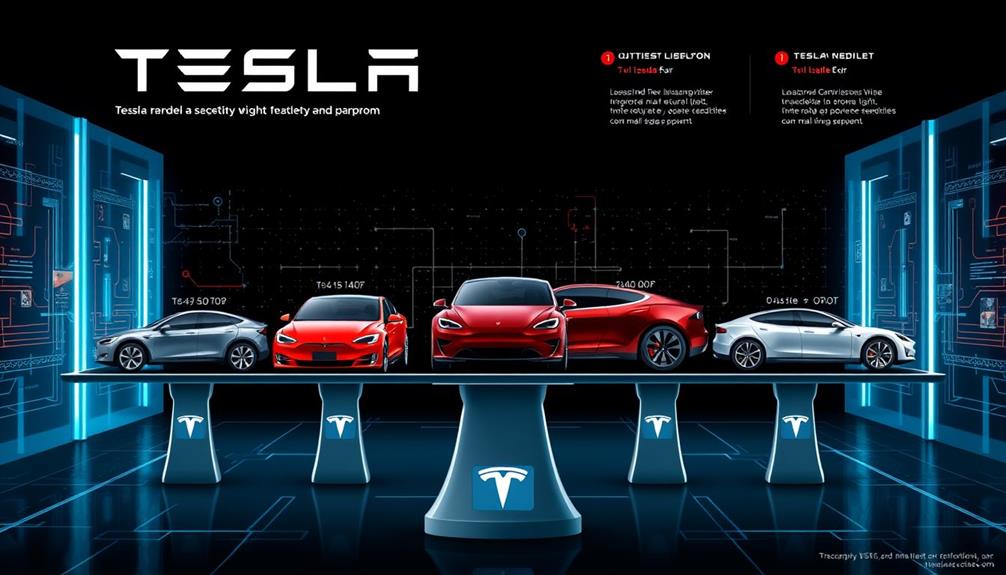
When you look at Tesla's lineup, you'll notice a wide range of vehicle weights that reflect their diverse models and capabilities. The lightest Tesla, the Roadster, weighs in at 2,723 pounds, while the heaviest, the Model X Plaid, tips the scales at a hefty 5,390 pounds. This significant variation highlights how weight is influenced by design and performance.
For those considering the Model S, the Long Range variant weighs 4,561 pounds, with the Plaid trim slightly heavier at 4,766 pounds.
The Model Y, positioned as a middleweight, maintains a consistent weight of 4,416 pounds across both its trims.
If you're eyeing the Model 3, you'll find it to be one of the lighter options, with the Standard Range Plus weighing 3,582 pounds and the Long Range and Performance trims at 4,065 pounds.
Tesla Roadster Weight Details
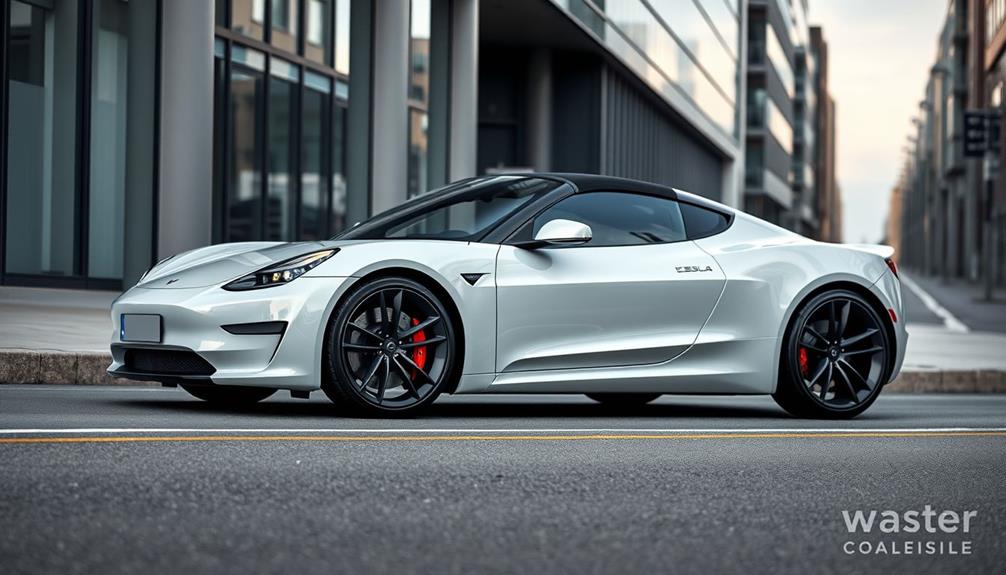
Let's explore the weight details of the Tesla Roadster, starting with the expected weight range for the second-generation model.
With predictions suggesting it could weigh between 4,400 and 4,700 pounds, it's essential to analyze how this impacts performance compared to Tesla's other models.
Understanding these factors will give you a clearer picture of what to expect from this high-performance electric vehicle.
Expected Weight Range
The weight of the second-generation Tesla Roadster is still under wraps, but estimates suggest it might land between 4,400 to 4,700 pounds. This anticipated weight range raises curiosity about how Tesla's innovative design and advanced technology will come together in this electric marvel.
While Tesla claims that the new Roadster will outperform its predecessor, the original model weighed just 2,723 pounds, making it the lightest Tesla to date.
As you ponder the potential weight of the new Roadster, consider these emotional highlights:
- The thrill of high-speed performance: A lighter car often translates into quicker acceleration.
- The fusion of luxury and technology: New motors and features could add heft but also enhance your driving experience.
- The excitement of owning a groundbreaking vehicle: This Roadster isn't just a car; it's a piece of the future.
While the exact specifications remain a mystery, the expected weight range of the second-generation Roadster continues to spark interest.
Keep an eye out for updates as Tesla reveals more information about this electrifying vehicle!
Performance Impact Analysis
Understanding the expected weight of the second-generation Tesla Roadster offers insight into its performance capabilities. With an anticipated weight range between 4,400 and 4,700 pounds, you might wonder how this heft affects the car's performance impact. The original Roadster weighed just 2,723 pounds, making it the lightest Tesla, but the new model compensates for its increased weight with revolutionary engineering.
Despite the added pounds, the second-generation Roadster is designed to achieve astounding acceleration, with estimates of 0-60 mph in just 1.9 seconds. There's even an optional SpaceX package that claims to push that figure down to an eye-watering 1.1 seconds. This impressive speed is achieved without sacrificing electric efficiency.
The engineers have struck a balance between weight and performance, ensuring the Roadster remains agile and quick. Its construction aims to enhance handling, allowing you to harness its power effectively.
While the weight range may seem hefty, it's this very design that enables the Roadster to deliver high performance while optimizing electric efficiency, making it a true contender in the electric vehicle market.
Comparison With Other Models
When comparing the second-generation Tesla Roadster to other models in Tesla's lineup, the weight difference becomes strikingly apparent. The original Roadster, weighing a mere 2,723 pounds, set the stage for Tesla's commitment to lightweight, high-performance electric vehicles.
However, the new Roadster is expected to weigh between 4,400 and 4,700 pounds, reflecting its enhanced size and capabilities.
This weight increase raises a few emotions for potential buyers:
- Excitement: Imagine the thrill of 0-60 mph in just 1.9 seconds!
- Curiosity: How will this weight impact the driving experience compared to the Model Long Range?
- Anticipation: The optional SpaceX package could push acceleration to an unbelievable 1.1 seconds!
While the weight of the second-generation Roadster hasn't been officially released, it's crucial to evaluate how it will compare to other Tesla models, like the Long Range variants.
The Roadster promises cutting-edge performance, but enthusiasts will need to weigh the benefits of speed against the increase in weight.
Ultimately, the new Roadster could redefine what you expect from an electric supercar, blending performance with the innovative spirit Tesla embodies.
Tesla Model S Weight Comparison
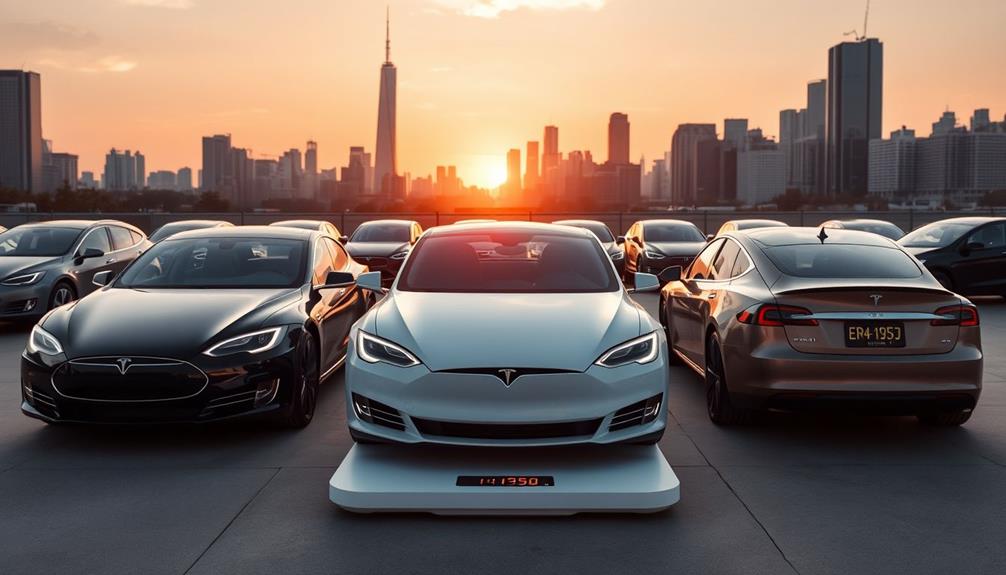
Although you might expect performance to come at a cost, the weight of the Tesla Model S reveals a fascinating balance between power and efficiency. The Tesla Model S Long Range weighs in at 4,561 pounds, offering a remarkable combination of range and speed. With 670 horsepower, this Long Range variant accelerates from 0-60 mph in just 3.1 seconds, proving that you don't have to compromise when it comes to performance.
On the other hand, the Plaid trim takes things up a notch. Weighing 4,766 pounds, it's slightly heavier, but that extra weight translates into even more power. With a staggering 1,020 horsepower, the Plaid trim catapults from 0-60 mph in an astonishing 1.99 seconds. This impressive acceleration showcases Tesla's engineering prowess, allowing for exhilarating performance without sacrificing efficiency.
Both trims feature dual motors and all-wheel drive, enhancing handling and stability.
Tesla Model X Weight Analysis
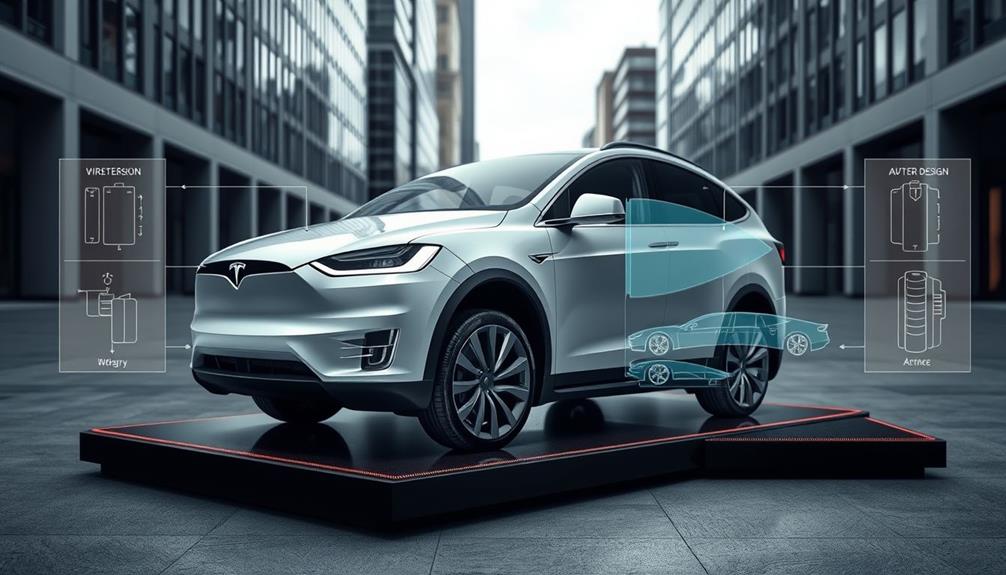
The Tesla Model X stands out as the heaviest member of the Tesla lineup, with its Long Range version tipping the scales at 5,185 pounds and the Plaid variant even heavier at 5,390 pounds.
While you might think weight could hinder performance, it actually enhances the Model X's capabilities. The Model X Long Range weighs more but boasts 670 horsepower, rocketing from 0-60 mph in just 3.8 seconds and offering a range of 348 miles.
On the other hand, the Plaid version delivers a staggering 1,020 horsepower, achieving the same acceleration in only 2.5 seconds, although it has a slightly reduced range of 333 miles.
Choosing the Model X means embracing the balance of weight and performance.
Consider these factors:
- Unmatched towing capacity for your adventures.
- Enhanced ride stability on diverse terrains.
- A spacious interior perfect for family trips.
In the world of electric vehicles, the Model X proves that weight isn't just a number—it's part of what makes it extraordinary.
You'll love the fusion of power and practicality that comes with this electric SUV.
Tesla Model Y Specifications
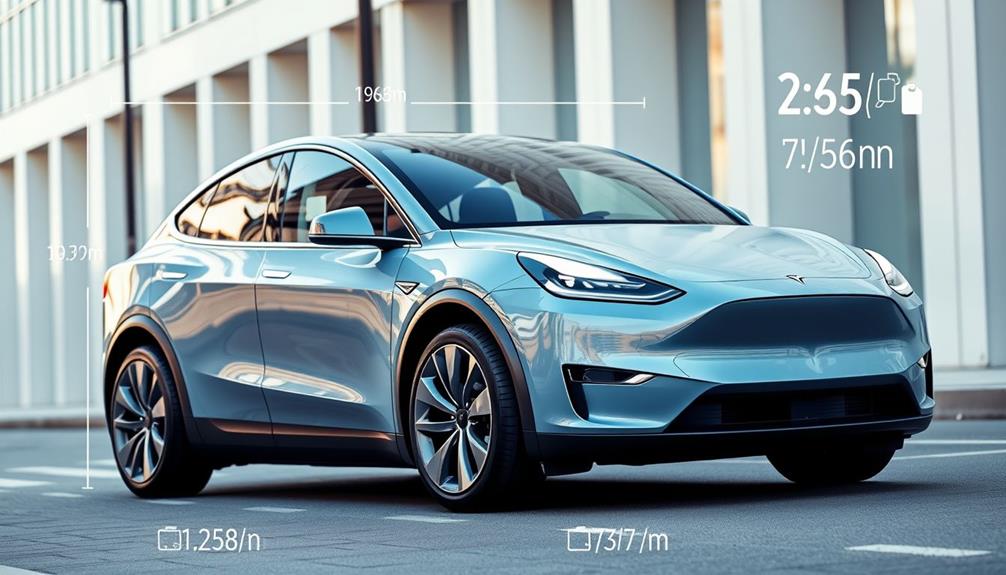
Versatility defines the Tesla Model Y, which weighs in at 4,416 pounds, placing it as the middleweight option among Tesla's electric offerings. This electric SUV, introduced in 2019, brings practicality and performance together, especially in its Long Range trim. Both the Model Y Long Range and Performance trims feature dual motors and all-wheel drive, ensuring an exhilarating driving experience.
Here's a quick comparison of the key specs:
| Feature | Model Y Long Range |
|---|---|
| Horsepower | 346 |
| 0-60 mph Acceleration | 4.8 seconds |
| Range | 330 miles |
| Feature | Model Y Performance |
| Horsepower | 450 |
| 0-60 mph Acceleration | 3.5 seconds |
| Range | 303 miles |
The Model Y Long Range offers impressive efficiency with its substantial range, making it a top choice among electric cars. Whether you prioritize performance or range, the Model Y caters to diverse driving needs, striking a balance that appeals to many drivers.
Tesla Model 3 Insights
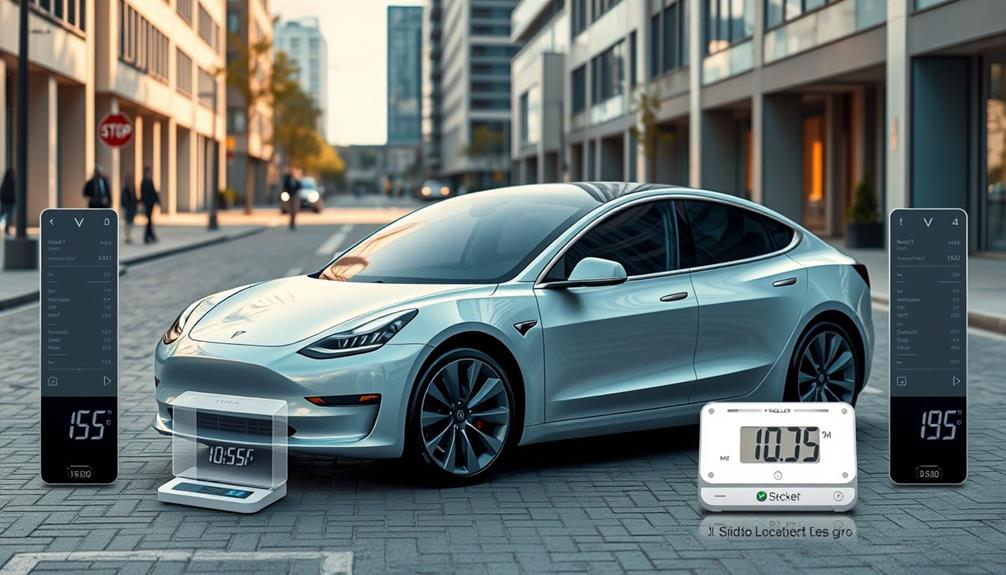
With its sleek design and impressive performance, the Tesla Model 3 has quickly become a favorite among electric vehicle enthusiasts. This remarkable car comes in various trims, each offering unique features and capabilities.
Whether you're drawn to the affordability of the Standard Range Plus or the exhilarating speed of the Performance model, there's a Model 3 for everyone.
- Feel the thrill of 0-60 mph in just 3.1 seconds with the Performance trim.
- Experience the incredible range of 358 miles in the Long Range Model 3.
- Enjoy the balance of power and efficiency with the Standard Range Plus.
Weighing in at 3,582 pounds for the Standard Range Plus and 4,065 pounds for the Long Range and Performance variants, the Model 3 remains one of the lighter electric vehicles on the market.
The Standard Range Plus features rear-wheel drive, achieving a respectable 0-60 mph in 5.8 seconds and a range of 272 miles. Meanwhile, the Model 3 Long Range offers all-wheel drive and quicker acceleration, making it a versatile choice for both daily commutes and thrilling drives.
Heaviest Tesla Models Ranked
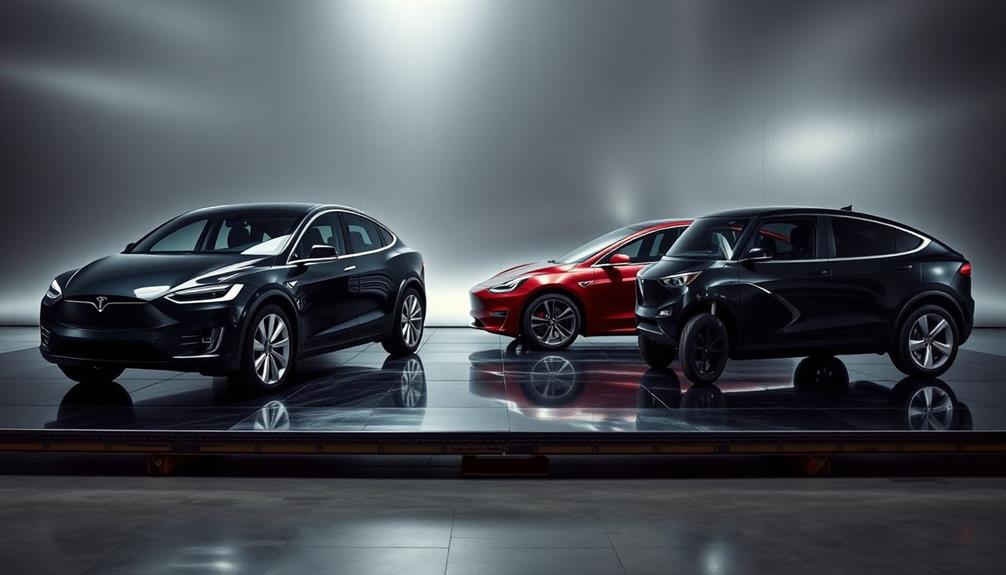
When it comes to weight, Tesla's lineup offers a range of models that vary considerably in heft, reflecting their design and capabilities.
If you're curious about the heaviest Tesla models, the top spot goes to the Model X Plaid, tipping the scales at a hefty 5,390 pounds. This impressive weight is due to its robust design and spacious interior, making it a popular choice for families.
Next in line is the Model X Long Range, weighing 5,185 pounds. This model combines luxury with performance, making it an appealing option for those who want both range and space.
Following closely is the Model S Plaid at 4,766 pounds, known for its breathtaking speed and cutting-edge technology.
The Model S Long Range, at 4,561 pounds, also provides a strong performance with a slightly lighter frame.
Rounding out the list, the Model Y weighs in at 4,416 pounds, offering a versatile SUV option without compromising on Tesla's signature efficiency.
Each model showcases a unique balance of weight and capability, allowing you to choose based on your specific needs.
Cybertruck Weight Expectations
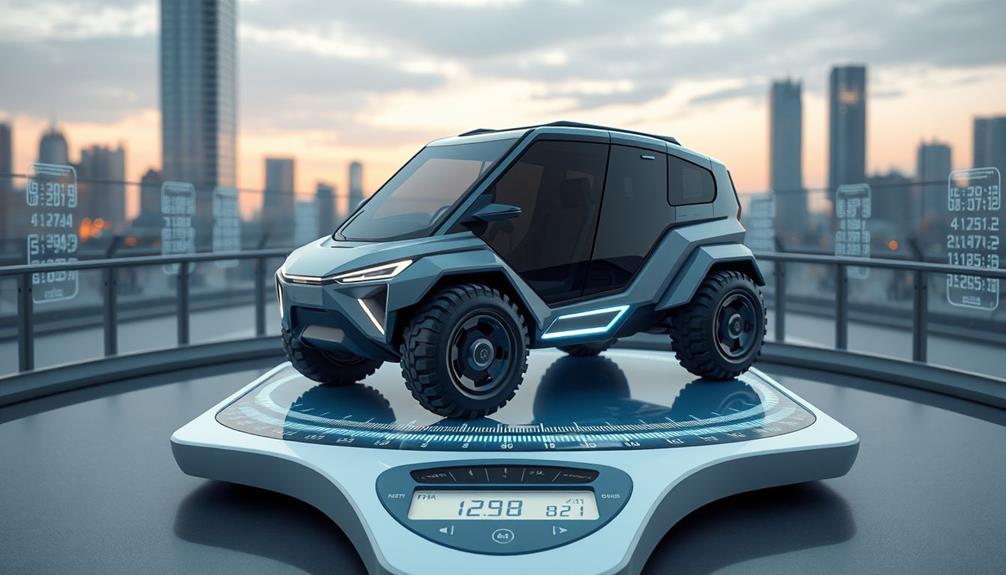
Tesla's much-anticipated Cybertruck is expected to weigh considerably more than its heavier counterparts, like the Model X. While the exact weight hasn't been officially confirmed, it's anticipated to fall between 5,000 and 6,500 pounds. The added size and impressive payload capacity contribute to this heft, making it a robust contender in the electric vehicle market.
Here's what you can expect from the Cybertruck's weight:
- The tri-motor variant, known as Cyberbeast, is speculated to tip the scales at around 6,843 pounds.
- The All-Wheel Drive version is projected to weigh approximately 6,603 pounds.
- The Rear-Wheel Drive variant should be lighter but remains unspecified.
This weight gives the Cybertruck a formidable presence on the road, ensuring it can handle tough terrains while still delivering that exhilarating electric performance you crave.
You'll love how its substantial weight translates to stability and power, especially when you're hauling heavy loads or maneuvering through rough landscapes.
With the Cybertruck, you're not just getting a vehicle; you're embracing a new way to experience driving.
2nd Generation Roadster Outlook

As you look ahead to the second-generation Tesla Roadster, you can expect its weight to range between 4,400 and 4,700 pounds, influenced by its advanced electric motors.
With a jaw-dropping 0-60 mph time of just 1.9 seconds, this model promises exhilarating performance, especially with the optional SpaceX package.
Keep an eye out for updates on its release timeline, as Tesla plans to share more details soon.
Expected Weight Range
In the domain of high-performance electric vehicles, the expected weight range for the second generation Tesla Roadster is generating considerable interest. While Tesla hasn't officially released the weight details, estimates suggest it will fall between 4,400 and 4,700 pounds.
This anticipated weight range reflects the size and performance characteristics of the new Roadster, which boasts advanced electric motors designed for incredible efficiency and power.
You might find yourself feeling exhilarated by the thought of:
- Lightning-fast acceleration from 0-60 mph in just 1.9 seconds
- Cutting-edge technology wrapped in a sleek, stylish design
- The thrill of driving a car that redefines performance standards
As you think about the second generation Roadster, remember that weight plays a vital role in its overall dynamics.
Tesla has indicated that more specific updates regarding the weight and other specs will be shared in future announcements. As you await these details, imagine how the combination of the expected weight range and innovative electric motors will enhance your driving experience and elevate your automotive dreams.
Performance Specifications Overview
With the second-generation Tesla Roadster, drivers can expect a thrilling blend of speed and technology. This remarkable vehicle boasts jaw-dropping performance specifications, including an impressive acceleration from 0-60 mph in just 1.9 seconds. Such speed positions the Roadster among the fastest production cars on the market today.
Tesla's innovative engineering promises a design that's not just powerful, but also optimized for performance. While the exact weight hasn't been officially released, estimates suggest it'll fall between 4,400 and 4,700 pounds. This weight range indicates that the second-generation Tesla Roadster will be lighter than many other high-performance electric vehicles, enhancing its agility on the road.
If you're craving even more excitement, there's talk of an optional SpaceX package that could potentially reduce acceleration to an astonishing 1.1 seconds. This advanced feature showcases Tesla's commitment to pushing the boundaries of electric vehicle performance.
As the anticipation builds around this cutting-edge Roadster, keep an eye out for updates from Tesla on its specifications and performance, as they continue to redefine what electric cars can achieve.
Release Timeline Insights
Anticipation surrounds the release of the second-generation Tesla Roadster, which was first announced back in 2017.
Initially, Tesla set a release timeline for 2022, but updates suggest it may have shifted. While you're keen to get behind the wheel, a few key aspects remain unclear.
- You can't wait to experience the mind-blowing acceleration from 0-60 mph in just 1.9 seconds.
- The optional SpaceX package could push that to an astonishing 1.1 seconds, igniting your adrenaline.
- You're curious about the weight details, with expectations hovering between 4,400 to 4,700 pounds.
Though Tesla hasn't released specific weight details yet, you can expect that the innovative electric motors will play a significant role in shaping both the performance and weight metrics of the second-generation Roadster.
Tesla continues to refine their electric vehicle technology, so stay tuned for updates.
As the excitement builds, you'll want to keep an eye on future announcements that will clarify the specs and release timeline. The dream of owning this electric powerhouse is closer than ever!
Electric Vehicle Weight Comparisons

Electric vehicles often showcase a diverse range of weights, reflecting their unique designs and capabilities. When you consider Tesla's lineup, you'll notice significant variations.
The Tesla Model X Long Range stands out as the heaviest at 5,185 pounds, while the nimble Tesla Roadster weighs in at just 2,723 pounds.
In the heavier category, the Tesla Model S Plaid weighs 4,766 pounds, closely followed by the Model S Long Range at 4,561 pounds. The Tesla Model Y, a versatile choice, has both trims weighing 4,416 pounds, making it a middleweight contender.
If you're looking for a lighter option, the Model 3 offers a range of weights: the Standard Range Plus at 3,582 pounds and both Long Range and Performance trims at 4,065 pounds each.
Looking ahead, the anticipated weight of the Tesla Cybertruck is expected to range between 5,000 and 6,500 pounds, depending on the specific model and configurations.
These weight comparisons highlight how each electric vehicle is tailored to different preferences, balancing performance and efficiency based on your needs.
Frequently Asked Questions
Which Teslas Weigh Over 6000 Pounds?
If you're curious about which Teslas exceed 6,000 pounds, check out the Cybertruck Cyberbeast at 6,843 pounds and the Cybertruck All-Wheel Drive at 6,603 pounds. They're hefty, but packed with performance!
Is an Electric Car Heavier Than a Normal Car?
You'll notice electric cars often weigh more than traditional ones. The hefty battery packs contribute considerably to this. Despite the extra weight, their efficient electric motors can make up for some of the difference.
Are Tesla's Heavier Than Normal Cars?
Yes, Tesla's tend to be heavier than traditional cars due to their electric battery systems. While this extra weight might surprise you, it doesn't hinder their impressive performance and acceleration compared to lighter vehicles.
How Much Does a Fully Electric Car Weigh?
So, you think electric cars float on air? Not quite! They weigh anywhere from 2,723 to 8,157 pounds, depending on the model. Those hefty batteries sure know how to pack on the pounds!
Conclusion
In the world of electric vehicles, Tesla stands as a heavyweight champion, each model carrying its unique load. From the sleek Roadster to the spacious Model X, understanding their weights helps you choose the perfect fit for your needs. As you navigate the roads of innovation, remember that every pound counts in the journey toward sustainability. With the upcoming Cybertruck and 2nd Generation Roadster, Tesla's future is as promising as a sunrise breaking through the clouds.
Alex is our go-to expert on performance tuning, with over a decade of experience in the automotive industry. His deep understanding of engine dynamics, exhaust systems, and performance software allows him to break down complex concepts into easy-to-follow guides. Whether you’re looking to boost horsepower or fine-tune your vehicle’s responsiveness, Alex’s insights will help you achieve peak performance.
Tesla Tuning
How Much Does Tesla Supercharging Really Cost? Here’s the Breakdown!
Baffled by Tesla Supercharging costs? Discover the surprising breakdown and find out how to save money on your next charging session!
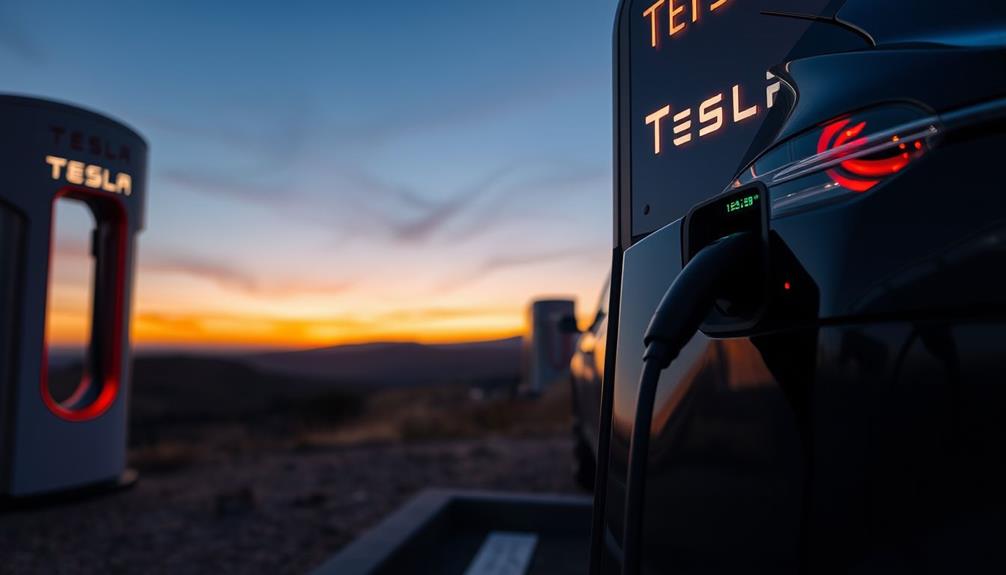
Tesla Supercharging costs generally range from $0.11 to $0.60 per kWh, leading to an average full charge costing around $27. For a typical 250-mile trip, you can expect to spend between $20 and $25 at a charging station. Keep in mind that Supercharging is generally pricier than home charging, which runs about $16 to $18.50 for the same distance. Watch out for idle fees if you're parked after charging, as they can add up quickly. If you stick around, you'll uncover more about the nuances of charging that can save you money.
Key Takeaways
- Supercharging costs range from $20 to $25 for 250 miles, with an average full charge around $27.
- Prices per kWh at Superchargers vary from $0.11 to $0.60, averaging about $0.25.
- Idle fees apply once charging is complete, costing $0.50 to $1.00 per minute, doubling at full capacity.
- Home charging is generally cheaper, costing between $16 and $18.50 for 250 miles compared to Supercharging.
- Charging with solar energy can reduce costs to approximately $0.06 per kWh, significantly lowering expenses.
Overview of Charging Costs

Charging your Tesla at a Supercharger station can cost you anywhere from $6 to $50, depending on your model and the charging rates. The average cost to achieve a full charge is about $27, but this varies based on your vehicle's battery capacity and the specific Supercharger rates.
Typically, Supercharger rates range from $0.11 to $0.60 per kWh, with an average price around $0.24 per kWh as of 2023.
For instance, if you're looking to travel 250 miles, expect to spend between $20 and $25 at a Supercharger. In contrast, home charging usually costs less, averaging between $16 and $18.50 for the same range.
You should also be aware of idle fees, which range from $0.50 to $1.00 per minute if you leave your vehicle connected after reaching the charging threshold.
These fees apply based on the station's capacity and can affect your overall charging costs. Understanding these factors can help you make more informed decisions when using EV charging stations for your Tesla.
Supercharger Pricing Breakdown

While the costs at Tesla Supercharger stations can vary, understanding the pricing breakdown is essential for planning your charging needs. Supercharger costs typically range from $0.25 to $0.50 per kWh, with some locations offering rates as low as $0.11 and as high as $0.60 per kWh.
On average, if you're looking to gain 250 miles of range, expect to spend between $20 and $25, depending on your vehicle model and local electricity rates.
One thing to keep in mind is the charging speed at Superchargers, allowing you to achieve about 200 miles of range in just 15 minutes. This makes them a convenient option for long-distance travel.
However, be aware of idle fees; once your vehicle is fully charged and the station is over 50% full, you'll incur charges of $0.50 to $1.00 per minute. If the station reaches full capacity, those fees double.
Ultimately, the average cost to fully charge a Tesla at a Supercharger is around $27 in 2024, but this can fluctuate considerably based on your model and the charging rates at specific locations.
Home Charging Expenses
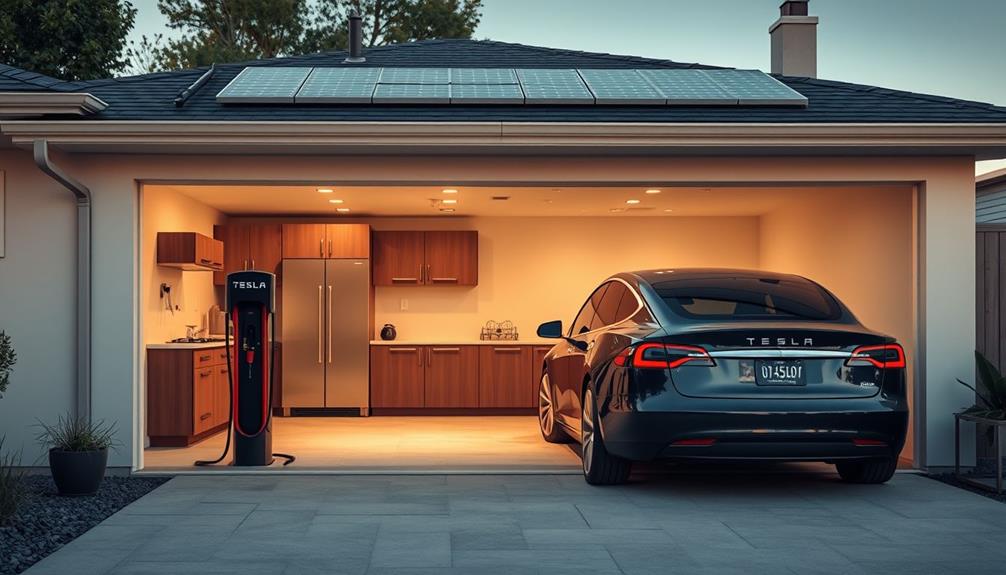
When it comes to home charging expenses, you'll find that powering your Tesla is generally more economical than using Superchargers. Charging at home not only saves you money but also offers the convenience of an overnight charging routine. The average cost to charge your Tesla for about 250 miles of range typically falls between $16 and $18.50, which is considerably lower than many Supercharger fees.
Here's a quick breakdown of costs:
| Item | Estimated Cost |
|---|---|
| Full charge (100 kWh) | $18.40 |
| Average U.S. electricity cost | $0.1609 per kWh |
| Energy loss (15% inefficiency) | $2.64 |
| Installing a home charger | $750 – $1,500 |
Free Charging Opportunities
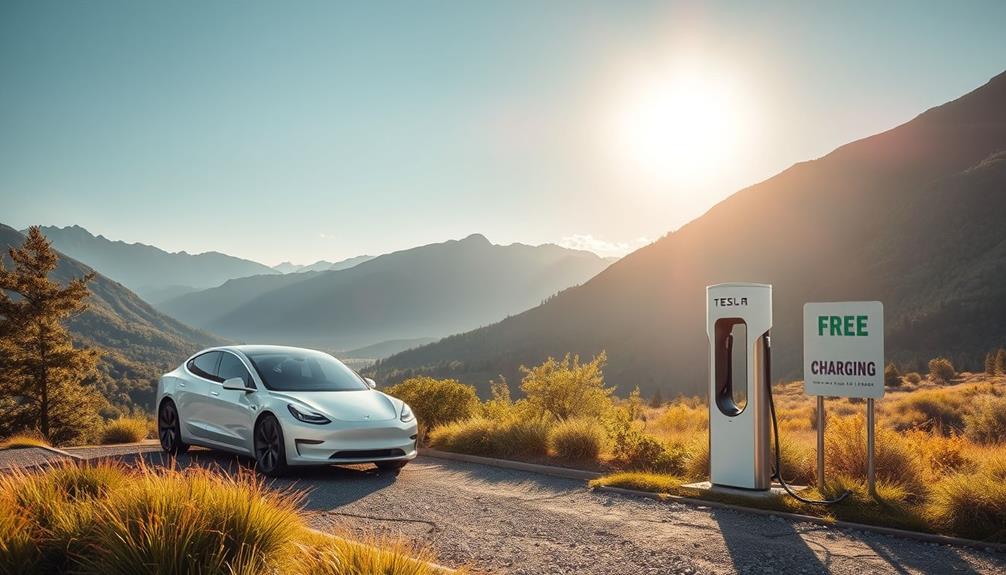
Although home charging is often the most economical choice for Tesla owners, there are still some free charging opportunities available if you know where to look. While free Supercharging offers were once a perk for certain Tesla models, most owners currently don't have access to these options. Historical promotions for free Supercharging credits have ended, with the last credits expiring on December 31, 2022.
However, you can still find cost-effective charging through the Tesla destination network. Many businesses in this network provide free or discounted EV charging, often conveniently located near community services.
Additionally, keep an eye out for select public charging stations that may offer free charging, although this is less common.
Looking ahead, Tesla plans to open its Supercharger network to non-Tesla EVs, which could expand your charging options and possibly introduce more free charging opportunities.
Staying informed about local promotions or changes in the EV landscape can help you maximize your charging savings. By utilizing these options, you can greatly reduce your overall charging costs and make the most of your Tesla ownership experience.
Charging Speed and Efficiency
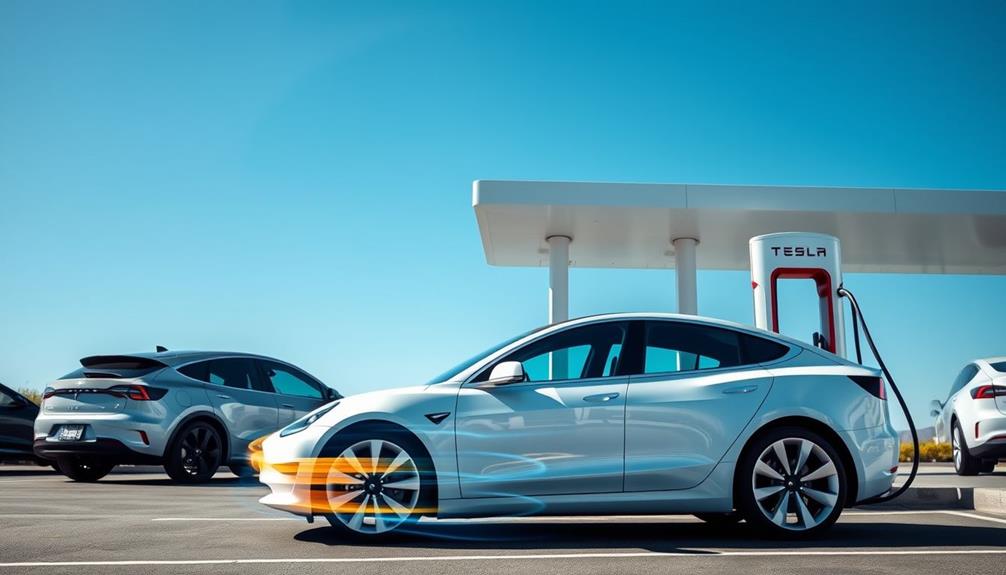
When you're on a long trip, the speed of Tesla Superchargers can make a huge difference.
With the ability to add up to 200 miles of range in just 15 minutes, you won't be stuck waiting around.
Plus, the high charging efficiency means you get more power with minimal energy loss, making each stop quick and effective.
Supercharger Speed Comparison
Tesla's Superchargers stand out for their remarkable charging speed and efficiency, making long-distance travel more convenient than ever. With supercharger speeds reaching up to 250 kW, you can gain up to 322 miles of range in just 15 minutes. This means you can quickly get back on the road without unnecessary delays.
Typically, charging from nearly empty to 80% takes only 15 to 30 minutes, depending on your model and battery capacity. This significant reduction in charging time is made possible by using DC electricity, which bypasses the onboard charger, enhancing charging efficiency.
In fact, Tesla's Superchargers boast a charging efficiency of over 90%, minimizing energy loss during the process.
When you consider charging costs, the benefits of using the Supercharger network become even more apparent. Not only do you save time, but you also maximize your driving range for each stop.
Whether you're starting a weekend getaway or a cross-country trip, Tesla's Supercharger speeds guarantee you can charge quickly and efficiently, making your long-distance travel experience smoother and more enjoyable.
Charging Time Efficiency
Charging time efficiency is a key factor that enhances the overall experience of using Tesla's Supercharger network. With Supercharger stations strategically located, you can charge your Tesla quickly and efficiently on long trips. These chargers deliver impressive charging speeds, providing up to 200 miles of range in just 15 minutes.
Here's a quick breakdown of charging times:
| Charge Level | Time (minutes) | Energy Efficiency (%) |
|---|---|---|
| Nearly Empty to 80% | 15 – 30 | >90 |
| Full Charge | 30 | >90 |
| Long-Range Models | 30 | >90 |
| DC Fast Chargers | Varies | >90 |
Utilizing direct current (DC) fast chargers, Superchargers bypass the onboard charger for faster, more efficient charging. The charging efficiency is reported to be above 90%, ensuring that most of the energy used to charge goes directly into your vehicle's battery. So, whether you're charging from nearly empty or topping off for a full charge, Tesla's charging network maximizes your time on the road.
Additional Fees and Charges
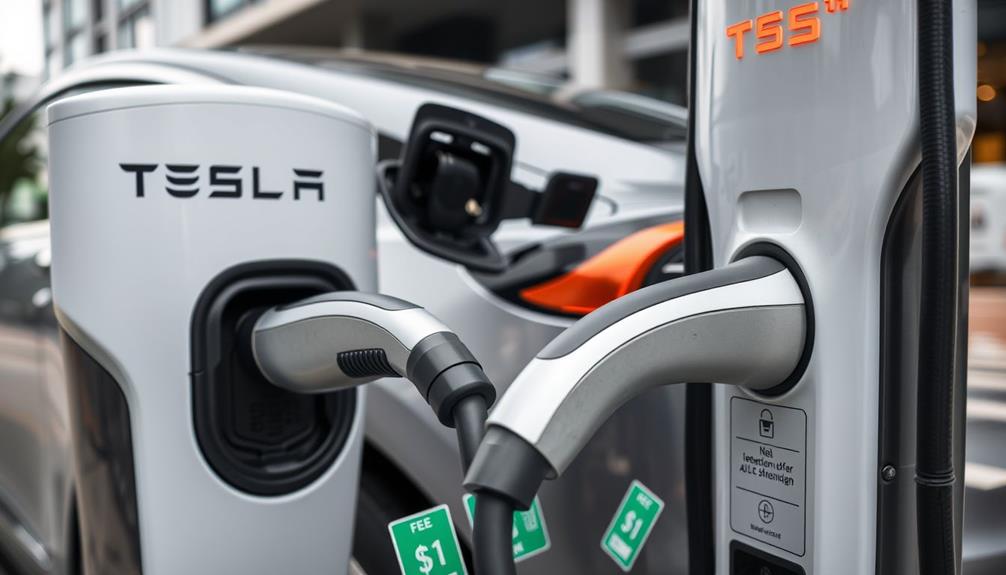
When using Tesla Superchargers, it's essential to understand the additional fees that can impact your overall costs.
Idle fees kick in once your vehicle reaches the charging threshold, and congestion charges apply during peak times if your battery is over 80% full.
Plus, Supercharging rates can vary greatly by location and time, so you'll want to keep an eye on those costs to avoid unexpected expenses.
Idle Fees Explained
While you might enjoy the convenience of Tesla Supercharger stations, it's important to be aware of idle fees that can add to your costs. Once your vehicle reaches a specified charge threshold, idle fees kick in, ranging from $0.50 to $1.00 per minute.
These fees only apply when the Supercharger station is at least 50% full, encouraging faster turnover of charging spots. If the station hits 100% capacity, the idle fee doubles, creating a strong incentive to move your vehicle promptly after charging.
To help you avoid unexpected charges, the Tesla app provides alerts when idle fees may apply. This is especially significant during peak hours when congestion fees of $1.00 per minute come into play if your battery is over 80% full.
Such fees emphasize the importance of efficient charging practices to keep costs down. By being mindful of your charging habits and promptly vacating charging spots, you can make the most of your Supercharging experience without incurring unnecessary expenses.
Stay informed and manage your charging time wisely!
Congestion Charges Overview
Often overlooked, congestion charges can greatly impact your Supercharging costs during busy times. When your Tesla's battery hits over 80% during peak hours, you incur congestion fees of $1.00 per minute. This can add up quickly, especially if you're not monitoring your charging time closely.
To help you navigate these fees, here are three key points to remember:
- Idle Fees: Once your vehicle reaches its charge threshold and the Supercharger station is 50% full, you'll face idle fees ranging from $0.50 to $1.00 per minute. This doubles to $2.00 if the station hits 100% capacity.
- Alerts: The Tesla app sends alerts to notify you when you might incur idle fees, helping you manage your charging time effectively.
- Turnover and Availability: These additional fees aim to encourage quicker turnover at busy Supercharger stations, optimizing availability for all users.
Being aware of congestion fees and idle fees will help you better plan your charging stops and minimize overall charging costs during peak hours.
Stay informed, and use the Tesla app to your advantage!
Additional Supercharging Costs
Understanding the costs associated with Tesla Supercharging goes beyond just congestion and idle fees. When you use Tesla Superchargers, you're subject to various additional fees that can affect your overall charging cost.
For instance, if your vehicle remains plugged in after reaching the charge threshold, you may incur idle fees ranging from $0.50 to $1.00 per minute, which can double when the station is full.
During peak hours, congestion fees of $1.00 per minute kick in if your battery is over 80% charged. These charges can greatly inflate your total costs.
The pricing models also vary depending on charging speed; with Tesla Superchargers delivering up to 350 kW, your costs may be calculated per kilowatt-hour (kWh) or per minute.
Typically, charging costs range from $0.11 to $0.60 per kWh, influenced by your location and time of day.
Be mindful of time-of-use rates, which fluctuate throughout the day, further impacting your final bill based on your energy consumption. Understanding these additional costs helps you plan your charging sessions more effectively.
Comparing Supercharging and Home Charging

When it comes to charging your Tesla, the choice between Supercharging and home charging can greatly impact your wallet.
While both methods serve your electric vehicle (EV), they differ considerably in cost and convenience.
Here's a breakdown of what you can expect:
- Cost Efficiency: Home charging typically costs between $16 and $18.50 for 250 miles, while Supercharging ranges from $20 to $25.
- Electricity Rates: The average price per kWh at Tesla Superchargers is about $0.25, compared to just $0.1609 for home charging.
- Charging Time: Superchargers can provide up to 322 miles of range in just 15 minutes, whereas home charging usually takes 4 to 10 hours for a full charge.
Charging With Solar Energy
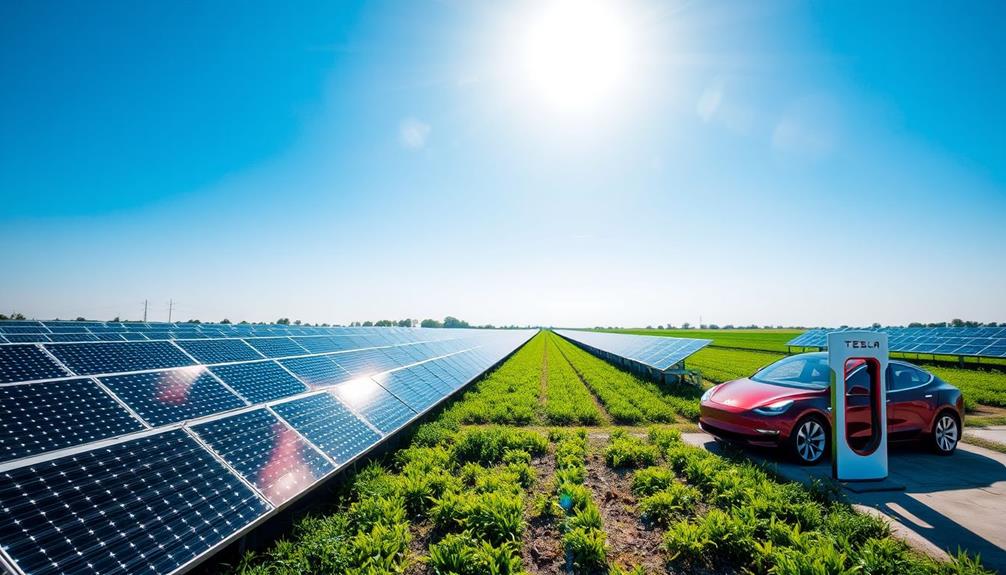
Charging your Tesla with solar energy presents an environmentally friendly and cost-effective solution for EV owners. By utilizing solar panels, you can reduce your charging costs to about $0.06 per kWh, which is considerably lower than Supercharging rates that typically range from $0.25 to $0.50 per kWh.
In fact, an average solar installation can generate enough electricity to meet the charging needs of your Tesla Model 3, requiring roughly five solar panels.
After the initial investment in a solar system, the electricity generated for charging becomes free, drastically lowering your overall operational costs. Many Tesla owners experience annual savings of around $1,500 when they rely on solar energy instead of Supercharging.
To maximize these benefits, it's wise to consult with a local solar installer. They can provide tailored assessments to determine the ideal number of solar panels based on your individual driving habits and geographic location.
With the right setup, you'll enjoy the convenience of charging your Tesla at home while contributing to a sustainable future.
Frequently Asked Questions
How Much Does It Cost to Fully Charge a Tesla at a Supercharger?
It typically costs you around $27 to fully charge your Tesla at a Supercharger in 2024. However, prices can vary based on your model and local electricity rates, ranging from $6 to $50.
How Much Is 15 Minutes on a Tesla Supercharger?
Think of Tesla Supercharging as fueling up a race car. Spending 15 minutes at a Supercharger typically costs you around $5, giving you about 200 miles of range, depending on your battery's state of charge.
Is It Cheaper to Charge a Tesla at Home or Supercharger?
When you're deciding between charging at home or a Supercharger, you'll find home charging's generally cheaper. With lower electricity rates and stable costs, you'll save money by plugging in overnight rather than at a station.
Is Supercharging Profitable for Tesla?
Yes, Supercharging's profitable for Tesla. You'll notice low charging costs, extensive locations, and high demand during travel. Combine that with idle fees, and you see how Tesla maximizes revenue while enhancing your driving experience.
Conclusion
To summarize, understanding Tesla supercharging costs is key to maximizing your EV experience. While supercharging may seem pricey, it often rivals or even beats traditional gas prices, especially when you factor in home charging and potential solar energy savings. It's worth considering the theory that frequent supercharging can actually extend battery life due to ideal charging conditions. So, weigh your options carefully, and you'll find that charging your Tesla can be both economical and efficient in the long run.
Alex is our go-to expert on performance tuning, with over a decade of experience in the automotive industry. His deep understanding of engine dynamics, exhaust systems, and performance software allows him to break down complex concepts into easy-to-follow guides. Whether you’re looking to boost horsepower or fine-tune your vehicle’s responsiveness, Alex’s insights will help you achieve peak performance.
Tesla Tuning
Do Teslas Have Engines? Find Out What Powers These EVs!
Curious about what powers Teslas? Discover the revolutionary technology behind these electric vehicles that sets them apart in the automotive world!

No, Teslas don't have traditional engines. Instead, they're powered by advanced electric motors that use energy stored in lithium-ion battery packs. These motors deliver instant torque, providing incredible acceleration and efficiency. For example, the Model S Plaid can go from 0 to 60 mph in under 2 seconds! The electric powertrain eliminates the need for complex transmissions, making the drive smoother. Plus, Tesla's Battery Management System guarantees longevity and peak performance. Curious about how these features impact your driving experience? Discover more about Tesla's innovative technology and performance enhancements that set them apart in the EV world!
Key Takeaways
- Tesla vehicles are powered by electric motors, not traditional internal combustion engines.
- Electric motors use electricity from lithium-ion battery packs for propulsion, providing instant torque.
- The Model S Plaid can accelerate from 0 to 60 mph in under 2 seconds due to its electric motor design.
- Tesla's advanced Battery Management System (BMS) regulates battery health, enhancing performance and longevity.
- With zero emissions during operation, Teslas contribute to a more sustainable driving experience compared to gasoline vehicles.
Understanding Electric Motors
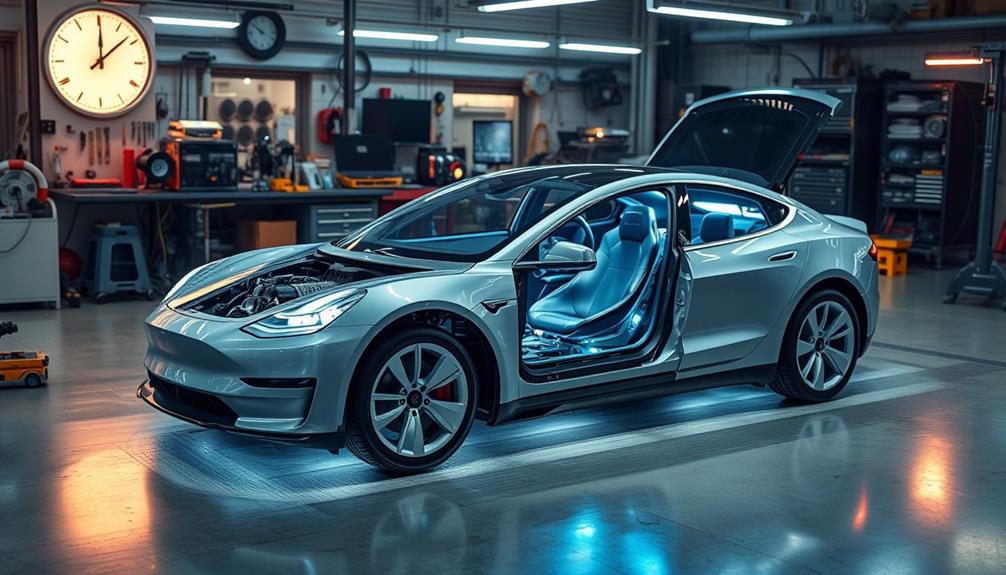
When you think about what powers a Tesla, it's essential to understand electric motors. Tesla vehicles rely on these innovative electric motors, which are powered by electricity stored in lithium-ion battery packs. Unlike traditional internal combustion engines, electric motors operate without the chemical conversion processes associated with gasoline, allowing for more efficient energy usage and a smaller carbon footprint.
These electric motors deliver a massive advantage in performance, producing 100% torque right from low speeds. This characteristic enables astonishing acceleration, with models like the Model S Plaid zooming from 0 to 60 mph in under 2 seconds. The advanced induction designs in Tesla's electric motors, particularly the rotor and stator arrangement in the Model S, further enhance efficiency and power delivery.
Additionally, the absence of conventional engines in Tesla vehicles creates unique design opportunities, such as the frunk (front trunk) that provides extra storage space. This clever design showcases one of the many benefits of electric vehicles, allowing for a more spacious and practical driving experience.
Understanding these electric motors is vital to appreciating the groundbreaking technology behind every Tesla you see on the road.
Tesla Powertrain Breakdown

When you think about the Tesla powertrain, it's vital to understand how electric motors function and the technology behind the batteries.
You'll find that the power conversion process plays a key role in delivering that instant torque that makes driving a Tesla so exhilarating.
Let's break down these components to see how they work together for peak performance.
Electric Motor Functionality
Tesla's innovative powertrain technology revolutionizes how electric vehicles operate, relying on electric motors instead of traditional engines. These electric motors draw power from Tesla batteries, which store large amounts of electricity for propulsion. The performance of these motors is boosted by an inverter that converts direct current (DC) from the battery into alternating current (AC), necessary for efficient movement.
One of the standout features of Tesla's electric motors is their ability to deliver instantaneous torque. This means you can experience rapid acceleration, like the Model S Plaid, which can zoom from 0 to 60 mph in under 2 seconds. Additionally, Tesla simplifies its drivetrain with a single gear transmission system, leveraging the electric motor's capacity to generate maximum torque at low speeds, enhancing overall efficiency.
Tesla's advanced battery management system (BMS) plays an essential role too. It optimizes the battery's performance and longevity, ensuring a lifespan that can reach up to 500,000 miles.
This combination of electric motors, effective BMS, and high-capacity Tesla batteries defines the impressive performance and reliability of Tesla vehicles, making them a leader in the electric vehicle market.
Battery Technology Insights
Electric vehicles like Teslas rely heavily on their battery technology to deliver performance and efficiency. At the heart of a Tesla is its advanced lithium-ion batteries, which store energy as direct current (DC). This energy is then converted to alternating current (AC) for the electric motors via inverters. Each battery pack consists of thousands of individual cells, allowing for impressive longevity—up to 500,000 miles before needing replacement.
The battery management system (BMS) plays an essential role in maintaining peak performance. It regulates the charging and discharging processes of the battery cells, ensuring they operate within safe parameters. This not only enhances the lifespan of the batteries but also maximizes efficiency, delivering power precisely when you need it.
Tesla continually innovates, incorporating technologies like neodymium iron boron magnets in its electric motors to reduce reliance on rare earth materials. Additionally, regular software updates keep your vehicle's battery range and efficiency at peak levels, showcasing Tesla's commitment to cutting-edge advancements.
With this robust battery technology, Teslas are engineered to perform exceptionally well while being environmentally sustainable.
Power Conversion Process
At the core of Tesla's power conversion process is the seamless interaction between its battery and electric motor systems. Tesla vehicles utilize lithium-ion batteries that store energy as direct current (DC). However, since electric motors require alternating current (AC), an inverter converts the DC to AC for efficient motor operation. When charging, a second inverter reverses this process, transforming AC power from the grid back to DC, ensuring smooth energy transfer.
Tesla's innovative drive system includes a sophisticated battery management system (BMS), which optimizes battery performance and longevity by monitoring usage and health. This simplicity in design eliminates the need for a complex transmission system, allowing for instant torque delivery and enhancing overall vehicle efficiency.
Here's a quick overview of the power conversion process:
| Component | Function |
|---|---|
| Lithium-Ion Battery | Stores energy as DC |
| Inverter (1) | Converts DC from the battery to AC for motors |
| Inverter (2) | Converts AC from the grid back to DC for charging |
| Battery Management System (BMS) | Monitors battery performance and health |
This streamlined process is what powers your Tesla efficiently.
Key Components of Tesla

When you think about Teslas, the electric motor and battery system are essential components that power the vehicle.
The electric motor converts electrical energy into motion, while the battery system stores that energy for use.
Understanding how these elements work together gives you insight into the innovative technology behind Tesla vehicles.
Electric Motor Functionality
Tesla vehicles utilize powerful electric motors that transform stored electricity into motion, revolutionizing the driving experience. Unlike traditional combustion engines, these electric motors offer instant torque, enabling impressive acceleration.
Each Tesla is equipped with a sophisticated battery management system (BMS) that maximizes battery performance and longevity, ensuring you can enjoy a lifespan of 300,000 to 500,000 miles before needing a replacement.
Here's a quick overview of the key components that make Tesla's electric motors so effective:
- Induction Motors: Generate propulsion through rotating magnetic fields.
- Single Gear Design: Eliminates the need for traditional transmissions, enhancing efficiency.
- Inverter: Converts DC power from the battery to AC power for the motors.
- Instant Torque: Provides rapid acceleration, making driving exhilarating.
- Thermal Management System: Regulates temperature to maintain ideal motor performance.
With these features, Tesla vehicles deliver a seamless and efficient driving experience. The combination of electric motors and advanced engineering sets Tesla apart in the electric vehicle market, offering you both performance and sustainability.
Battery System Overview
Electric vehicles like Teslas rely on advanced battery systems that play an essential role in their overall performance. At the heart of every Tesla is a battery pack made up of thousands of individual lithium-ion cells. These cells store energy as direct current (DC), which is then converted to alternating current (AC) to power the electric motors, ensuring a smooth and efficient driving experience.
A key player in this system is the battery management system (BMS). It enhances battery performance by monitoring each cell's health and ensuring efficient energy distribution to the motors. This not only boosts performance but also extends the battery's lifespan.
Additionally, Tesla incorporates an advanced thermal management system that regulates battery temperature. This is critical for maintaining peak performance and safety, especially during heavy usage or extreme weather conditions.
Beyond the main battery pack, components like inverters and DC/DC converters facilitate power conversion and distribution throughout the vehicle, ensuring that every part receives the energy it needs to function correctly.
Together, these elements make Tesla's battery system one of the most sophisticated in the electric vehicle market.
Motor Configurations Explained
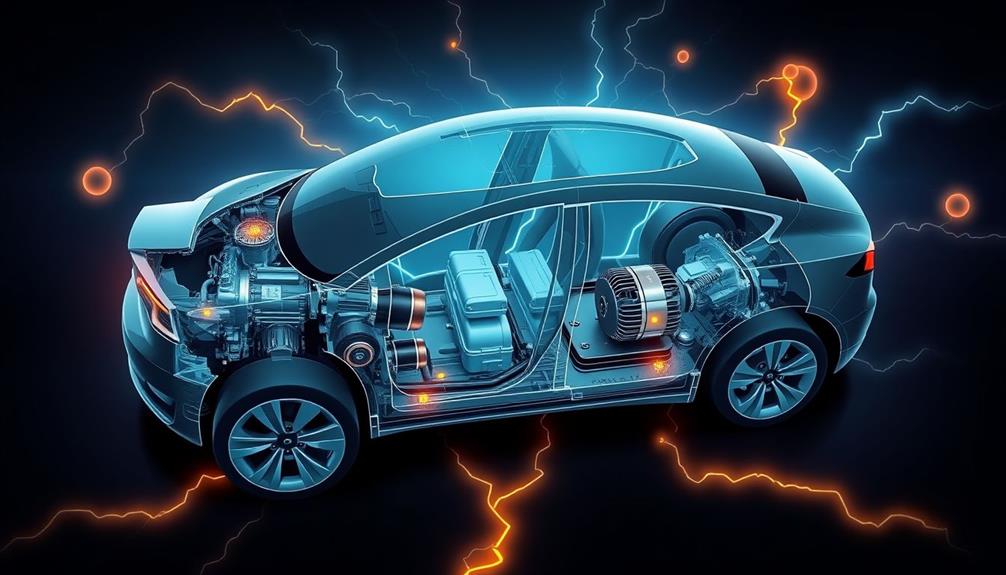
Understanding motor configurations is essential for grasping how Teslas deliver their impressive performance.
Tesla offers several setups that cater to different driving needs and preferences, leveraging advanced electric motor technology for unparalleled acceleration.
Here's a quick breakdown of Tesla's motor configurations:
- Single-Motor RWD: Found in the Model 3 and Model Y, this setup provides a straightforward and efficient power delivery.
- Dual-Motor AWD: Introduced in 2015, this configuration enhances traction, making it perfect for various driving conditions, from rain to snow.
- Tri-Motor Drivetrain: Revealed in 2021, this system allows high-performance models like the Model S and Model X to achieve astonishing acceleration.
- Instant Torque: All configurations utilize electric motors, delivering power instantly, which greatly improves driving dynamics.
- Versatile Options: Each motor configuration is designed to cater to diverse consumer preferences, ensuring there's a Tesla for everyone.
Charging Tesla Vehicles
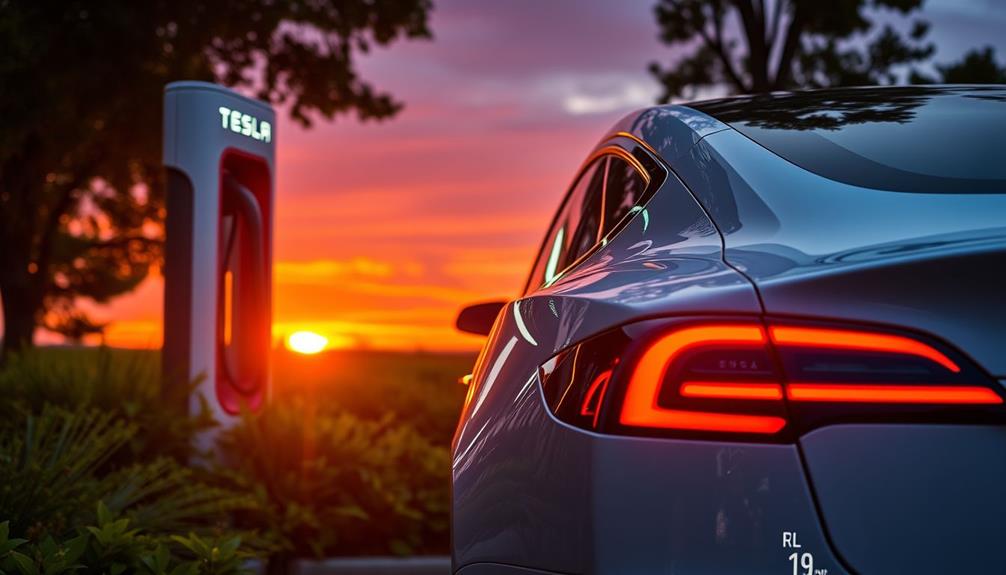
When it comes to charging your Tesla, the options are plenty and designed for convenience. Your vehicle runs on lithium-ion batteries, which store energy as direct current (DC). You can choose from several charging options: Level 1, Level 2, or the super-fast Supercharging stations.
With around 16,822 Superchargers and destination chargers across the U.S., rapid charging is easily within your reach.
Charging your Tesla for about 500 miles costs you approximately $23, which is a stark contrast to the $50 you'd spend on gasoline for the same distance. This not only highlights the cost-effectiveness of electric vehicles but also encourages you to contemplate home charging installations, which can considerably lower your travel expenses.
Plus, there are various incentives available to help with these installations.
To make your experience even smoother, Tesla's mobile app provides real-time information on the availability of charging stations. This means you can effortlessly locate nearby charging options, ensuring you're never left in the lurch.
Embracing these modern charging solutions makes owning a Tesla both practical and economical.
Environmental Benefits of EVs

When you choose a Tesla, you're opting for a vehicle that produces zero emissions during operation, which helps cut down on greenhouse gases.
These electric vehicles not only enhance energy efficiency but also support sustainability by relying on renewable energy sources.
Reduced Greenhouse Gas Emissions
Electric vehicles, like Teslas, are transforming the automotive landscape by greatly reducing greenhouse gas emissions. Unlike conventional gas-powered vehicles, Teslas operate on electric motors powered by lithium-ion batteries, resulting in zero tailpipe emissions. This shift to electric vehicles markedly cuts down on the carbon dioxide produced over their lifetime.
Here's how Teslas help in reducing greenhouse gas emissions:
- Zero tailpipe emissions: No harmful pollutants released while driving.
- Lower lifetime carbon footprint: Electric vehicles produce less CO2 than internal combustion engines.
- Enhanced energy efficiency: Tesla's electric drivetrain consumes less energy per mile.
- Battery management system (BMS): Optimizes battery usage, improving overall efficiency and reducing waste.
- Active contribution to climate change solutions: By choosing Teslas, you participate in reducing your carbon footprint.
With these advancements, you're not just driving a Tesla; you're making a conscious choice to support a greener planet.
Sustainability and Renewable Energy
Sustainability and renewable energy are at the forefront of the electric vehicle revolution, and Teslas play a key role in this transformation. By producing zero emissions during operation, Teslas considerably cut down greenhouse gas emissions compared to traditional gasoline vehicles. Their electric drivetrains convert over 90% of stored energy into motion, enhancing energy efficiency.
Here's how Teslas contribute to sustainability:
| Aspect | Impact |
|---|---|
| Zero Emissions | Reduces air pollution and greenhouse gases |
| Long Battery Life | Supports sustainable energy practices with lifespans up to 500,000 miles |
| Reduced Fossil Fuel Dependence | Promotes a shift towards renewable energy sources |
Transitioning to electric vehicles like Teslas not only helps you reduce your carbon footprint but also encourages a broader move toward renewable energy. Tesla's commitment to sustainability shines through their research into rare earth-free permanent magnets, minimizing environmental impacts in manufacturing. By choosing a Tesla, you're not just selecting an innovative vehicle; you're actively participating in a cleaner, more sustainable future.
Energy Efficiency Advantages
Tesla vehicles offer impressive energy efficiency advantages that greatly benefit the environment. By operating solely on electric motors powered by lithium-ion batteries, Teslas produce zero emissions, notably reducing your carbon footprint compared to gasoline-powered vehicles.
Investing in electric vehicles is part of a broader strategy for sustainability, as diversification in investments can include green technologies. You'll enjoy remarkable cost savings and lower environmental impact with every mile you drive.
Here are some key energy efficiency benefits of Tesla electric vehicles:
- Low charging costs: About $23 to charge for 500 miles, versus around $50 for gasoline.
- Long battery lifespan: Batteries last between 300,000 to 500,000 miles, decreasing waste.
- Simple electric drivetrain: Fewer moving parts mean less energy loss and better efficiency.
- Advanced technology: Tesla's electric motors optimize energy management for long-lasting performance.
- Support for sustainability: Shifting to electric vehicles helps reduce greenhouse gas emissions.
These factors combined make Tesla a smart choice for anyone looking to contribute to a cleaner planet while enjoying the benefits of energy-efficient travel.
With Tesla, you're not just driving a car; you're making a positive impact on the environment.
Performance Highlights of Tesla

While you might think of performance regarding traditional engines, Tesla redefines it with their cutting-edge electric motors. One of the most impressive performance highlights is the Model S Plaid, which zips from 0 to 60 mph in just 1.99 seconds, making it the fastest mass-production vehicle on the market.
If you're considering something a bit more compact, the Model 3 Performance boasts an upgraded 5D1 motor that can hit 0 to 60 mph in approximately 2.9 seconds while generating around 500 horsepower.
Tesla's electric powertrains deliver a driving experience that's both exhilarating and efficient. The instant torque provided by electric motors enhances the overall driving dynamics, making every Tesla model responsive and fun to drive.
Additionally, the tri-motor setup in the Semi truck showcases the versatility of these electric powertrains, delivering exceptional heavy-duty performance.
Looking ahead, the anticipated Cybertruck is expected to feature three motors, optimizing performance across various driving conditions.
With these advancements, Tesla continues to push the boundaries of what's possible in electric vehicle performance, ensuring that you get a thrilling ride every time.
Tesla's Innovative Technology

In the world of electric vehicles, innovative technology sets Tesla apart from traditional automakers.
You'll find that Tesla's approach to engineering focuses on maximizing efficiency and performance through cutting-edge solutions.
Here are some key features that highlight their innovation:
- Electric Motors: Unlike conventional cars, Teslas use electric motors that deliver instant torque and a smooth driving experience.
- Battery Management System (BMS): Tesla's sophisticated BMS optimizes battery performance and longevity, ensuring you get the most out of your vehicle.
- Long Battery Lifespan: Their lithium-ion batteries can last between 300,000 to 500,000 miles, reducing the need for replacements.
- Dual Motor System: Many models, including the Tesla Model S, feature this system for better torque distribution and reliability, even if one motor fails.
- 5D1 Motor: The upcoming 2024 Model 3 will introduce this motor, enhancing performance to achieve 0 to 60 mph in about 2.9 seconds.
With these advancements, Tesla isn't just changing how we drive; they're redefining the entire automotive landscape.
Market Position of Tesla
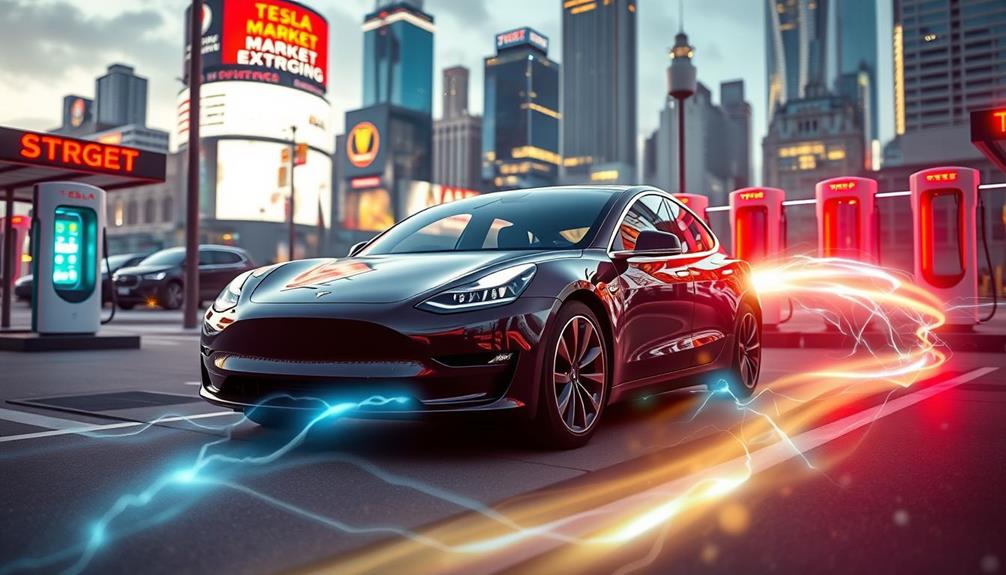
The market position of Tesla is nothing short of impressive, solidifying its status as the best-selling luxury car brand in the U.S. As electric vehicles gain traction, more consumers are drawn to Tesla's innovative technology and sustainable transportation solutions.
This growing interest is reflected in the diverse lineup of Tesla models, priced between approximately $39,000 and $91,000, catering to various market segments.
The introduction of the 2024 EV tax credit has further boosted Tesla's market attractiveness, making its vehicles even more appealing to potential buyers. This incentive encourages consumers to contemplate electric vehicles, positioning Tesla as a leading choice in the industry.
What truly sets Tesla apart is its continuous advancements in electric technology and unwavering commitment to sustainability. These factors not only enhance its market position but also build brand loyalty among environmentally conscious consumers.
In a competitive automotive landscape, Tesla's focus on innovation and consumer needs keeps it ahead of the curve. As you explore your options in electric vehicles, it's clear that Tesla stands out, making significant strides in shaping the future of transportation.
Driving Experience in Teslas

Tesla's unique approach to vehicle design directly influences the driving experience in its cars. With electric motors instead of traditional engines, you'll feel the instant torque that provides impressive acceleration. This shift to electric power transforms how you interact with your vehicle, making every drive exhilarating.
Here are some key features that augment your driving experience in a Tesla:
- Instant Acceleration: Electric motors deliver power immediately, putting you in control.
- Precise Steering: The electric power steering (EPS) system guarantees responsive handling.
- Safety Features: Advanced driver-assistance systems (ADAS) like lane departure warning enhance safety.
- Autopilot: This feature allows for self-steering under specific conditions, making long drives less stressful.
- Single Gear Transmission: Enjoy smooth acceleration without the interruptions of gear shifting.
Frequently Asked Questions
What Determines the Power of an Ev?
The power of an EV is determined by its electric motor configuration, battery capacity, and advanced technologies. You'll notice that setups like dual or tri-motor enhance acceleration and overall performance considerably, making your driving experience thrilling.
Do Teslas Lose Power Over Time?
Yes, Teslas can lose power over time, but their battery lifespan is substantial. By monitoring your battery health through the app and maintaining good charging habits, you can help preserve its efficiency and performance.
Do Teslas Lose Acceleration Over Time?
Imagine you're driving your Tesla for years. You'll notice it maintains impressive acceleration, even as battery capacity decreases. Regular software updates and efficient electric motors guarantee you won't experience significant loss in performance over time.
Do Teslas Need Oil Changes?
No, Teslas don't need oil changes. Instead of traditional engines, they use electric motors powered by lithium-ion batteries, which means you can focus on tire rotations and brake checks for maintenance instead.
Conclusion
In the world of electric vehicles, Teslas stand out like stars in the night sky. Instead of traditional engines, they harness electric motors to deliver impressive performance and efficiency. With cutting-edge technology and a unique powertrain design, driving a Tesla isn't just about getting from point A to B; it's about experiencing the future of mobility. So, if you're ready to embrace innovation, hop in and feel the electric thrill that only a Tesla can provide!
Alex is our go-to expert on performance tuning, with over a decade of experience in the automotive industry. His deep understanding of engine dynamics, exhaust systems, and performance software allows him to break down complex concepts into easy-to-follow guides. Whether you’re looking to boost horsepower or fine-tune your vehicle’s responsiveness, Alex’s insights will help you achieve peak performance.
-

 Tesla Tuning2 months ago
Tesla Tuning2 months agoTesla Cybertruck Sales: How Many Have Been Sold So Far?
-

 Tesla Tuning2 months ago
Tesla Tuning2 months agoWhere Are Tesla Cars Made? Explore the Manufacturing Locations!
-
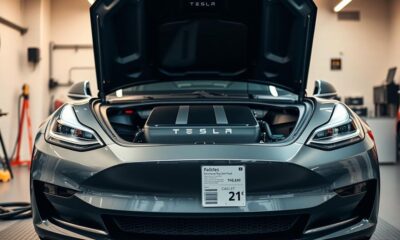
 Tesla Tuning3 months ago
Tesla Tuning3 months agoTesla Battery Replacement Costs Revealed: How Much Will You Pay?
-

 Tesla Tuning2 months ago
Tesla Tuning2 months agoSupercharging Tesla: How Long Does It Really Take?
-
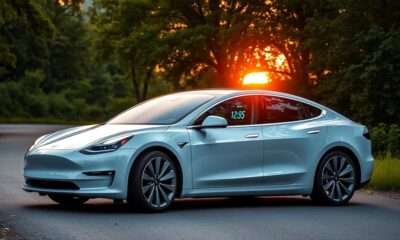
 Tesla Tuning3 months ago
Tesla Tuning3 months agoTesla Mileage: How Many Miles Can You Drive on a Full Charge?
-

 Tesla Tuning2 months ago
Tesla Tuning2 months agoHow Much Does It Cost to Lease a Tesla? Get the Full Breakdown!
-
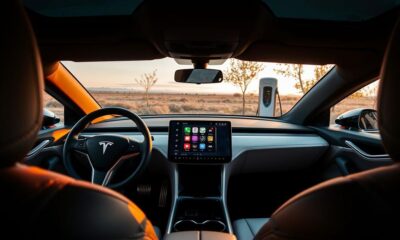
 Tesla Tuning3 months ago
Tesla Tuning3 months agoTesla CarPlay: Does Tesla Have Apple Integration?
-

 Tesla Tuning3 weeks ago
Tesla Tuning3 weeks agoTesla Fire Incidents: How Many Teslas Have Caught Fire?


















